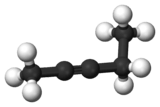2-Pentyne
 | |
 | |
| Names | |
|---|---|
| IUPAC name
Pent-2-yne | |
| Other names
Ethylmethylacetylene, 1-Ethyl-2-methylacetylene | |
| Identifiers | |
| 627-21-4 | |
| 3D model (Jmol) | Interactive image Interactive image |
| ChemSpider | 11807 |
| ECHA InfoCard | 100.009.991 |
| PubChem | 12310 |
| |
| |
| Properties | |
| C5H8 | |
| Molar mass | 68.12 |
| Density | 0.71 g/mL |
| Melting point | −109 °C (−164 °F; 164 K) |
| Boiling point | 56 to 57 °C |
| Hazards | |
| Main hazards | Flammable Liquid |
| Except where otherwise noted, data are given for materials in their standard state (at 25 °C [77 °F], 100 kPa). | |
| | |
| Infobox references | |
2-Pentyne, an organic compound, is an internal alkyne. It is an isomer of 1-pentyne, a terminal alkyne.
1-Pentyne
Synthesis
2-Pentyne can be synthesized by the rearrangement 1-pentyne in a solution of ethanolic potassium hydroxide.[1]
References
- ↑ Victor von Richter and Hans Meerwein (1916). Organic Chemistry: Chemistry of the aliphatic series Vol. I: Smith's 3rd American Ed. Philadelphia: P. Blakiston's Sons & Co. p. 89.
External links
This article is issued from Wikipedia - version of the 10/27/2016. The text is available under the Creative Commons Attribution/Share Alike but additional terms may apply for the media files.